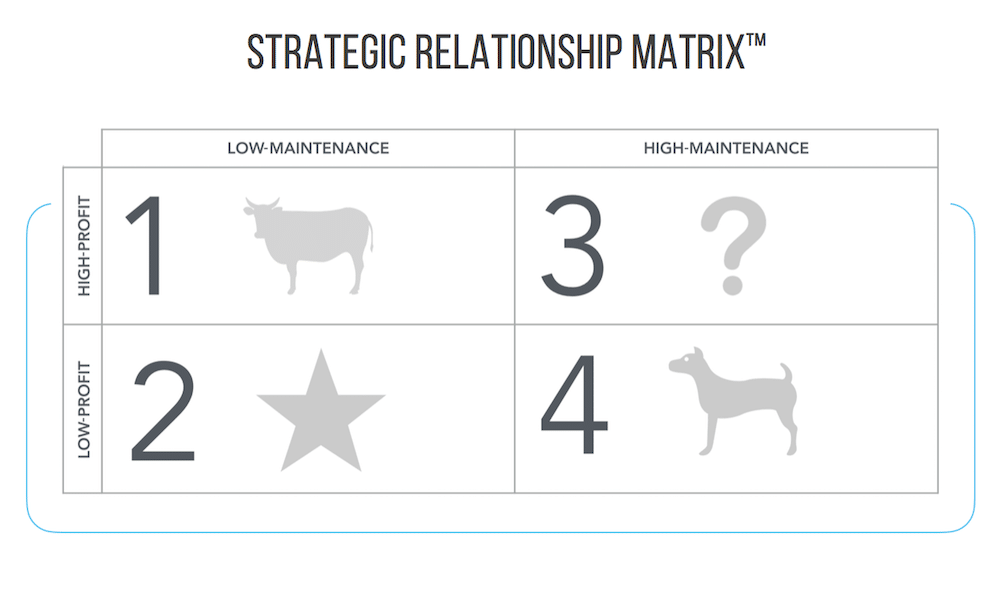4 Ways to Separate the Milk From the Dogs
It’s one of the toughest questions in business: Who should you be working with? Several years ago, when I was CEO of Thomas Nelson, I had one of those moments of clarity that has broad application for organizations.
The “aha!” moment came when I was thinking about our professional relationships with authors and agents. Some relationships were highly profitable and enjoyable. Others were also quite profitable but a constant drain on our staff and resources.
Still others were enjoyable but not very rewarding financially. And of course there were the worst kind of relationships from our perspective: unprofitable and annoying.
Drawing the Matrix
To sort them out, I imagined a two-by-two matrix, similar to the Boston Consulting Matrix. The horizontal axis represented maintenance and the vertical axis represented profit. Then I drew that matrix out. Click here to download the pdf.

When I stepped back to look at it, I realized that it describes just about every kind of professional relationship you can have. That's because every business relationship falls somewhere on the continuum of profitability: highly profitable, marginally profitable, or completely unprofitable. Every professional relationship also requires a certain amount of maintenance that we can plot on the other axis.
Setting Relationship Priorities
This idea became practical for me when I realized I could use this matrix to figure out how to prioritize my clients. It can provide that same clarity for you, too.
Priority 1
These are the high-profit/low-maintenance relationships. They don’t require a lot of energy to service, and they yield big profits.
Client relationships that fall into this category are delightful. Everyone is happy. The secret to success in business is to develop more of these relationships. They are the cash cows.
Priority 2
These are the low-profit/low-maintenance relationships. The reason these relationships are second in priority is because they have at least half of the equation right: they are low maintenance.
Your hope is that with a little work, you can also make them highly profitable. They are the bright and shining stars with lots of unreached potential. In terms of how you allocate resources, these should be your second priority.
Priority 3
These are the high-profit/high-maintenance relationships. These are probably the most frustrating. They seem too profitable to exit. But they require so much maintenance, you are often left wondering whether it is worth the effort. As a result, they are a perpetual question mark.
The key is to try and move these relationships into the Priority 1 quadrant. If you can’t do this, then it’s best to bite the bullet and exit the relationship. These difficult partnerships drain time you could otherwise invest in finding more Priority 1 relationships or in making your Priority 2 relationships more profitable.
Priority 4
These are the low-profit/high-maintenance relationships. They are “dogs” at least in terms of the value to your organization. They are a huge waste of resources. They wear out your staff. They have little or no potential. It can be tough to face, but the sooner you come to grips with this reality, the better.
Getting rid of relationships that fall into this category will allow you to reclaim resources you can invest in finding or serving Priority 1 clients. Typically, once you exit this kind of relationship, you wonder why you didn’t do it sooner.
Plot Your Relationships, Plot Your Course
I suggest that you take some time and plot your current business relationships on this matrix. Once you’ve done that, here are some practical strategies for how to proceed by region.
- Priority 1 Action: Schedule time to prospect for more of these clients and make time to super-serve the ones you have. They may be low-maintenance but a little extra attention might pay big dividends.
- Priority 2 Action: Schedule time to brainstorm with your team how to make these more profitable. You like working with these people. If you can make it more rewarding to do so, everybody wins.
-
Priority 3 Action: Schedule time to have the hard conversation about why this relationship might not be a good fit.
Be frank with these folks. Tell them that you value their contribution but you also value your team’s time and effort. Help them better understand the costs of what they’re demanding–and the impact of those demands on your working relationship.
Sometimes having that difficult discussion is all it takes to create a change in their behavior and move them closer to the low-maintenance category. -
Priority 4 Action: Schedule a time to have the hard conversation with the client about why your relationship is not a good fit.
Be professional, though they may have been rude to you and your team. Tell them that you’ve done some hard thinking and it just isn’t worth doing this anymore, wish them the best, and call it a day.
Put Yourself on the Matrix
Incidentally, this Matrix also works in reverse. To determine where you might fall on someone else's grid, just write a quick list of what would define a profitable, low-maintenance relationship in your space. Here's an example of a list I made while I was at Thomas Nelson to gauge how we were doing.
Profile of the Ideal Publisher
| High Profit | Low Profit |
| 1. Demonstrates a win-win financial paradigm. | 1. Demonstrates a win-lose financial paradigm. |
| 2. Offers competitive advances and royalty rates. | 2. Does not offer competitive advances or royalty rates. |
| 3. Makes advance and royalty payments on a timely basis. | 3. Takes forever to pay advances or is slow in paying royalties. |
| 4. Maximizes product sales through every market channel. | 4. Focuses on only two or three market channels. |
| 5. Proactively manages client’s backlist and, as a result, maximizes royalty income. | 5. Allows backlist titles to languish or slip out of print, costing the author royalty income. |
| 6. Refers prospective author clients to us (i.e., the agent). | 6. Wouldn’t think of referring a prospective author client to us, let alone do it. |
| Low Maintenance | High Maintenance |
| 7. Sees the agent as a partner (i.e., a customer), welcomes his involvement, and reinforces his role with the author. | 7. Sees the agent as an adversary (i.e., “the enemy”), resents his involvement, and tries to undermine his role with the author. |
| 8. Has a standard contract for the agency so that contracts can be negotiated quickly. | 8. Everything must be negotiated from scratch every time, adding cost and frustration. |
| 9. Distributes easy-to-understand royalty statements. | 9. Distributes confusing royalty statements. |
| 10. Responds promptly to inquiries, proposals, and completed manuscripts. | 10. Is slow or negligent in responding to inquires, proposals, and completed manuscripts. |
| 11. Takes the initiative to prepare a written marketing plan and follows up on it. | 11. Only prepares a marketing plan when the agent demands it and then, once created, hopes the agent and the author forget about it. |
| 12. Proactively provides information—including sales information—to the agent on a regular basis. | 12. Reactively provides information to the agent—if at all. |
| 13. Under-promises and over-delivers, thereby making the agent look good with his or her clients. | 13. Over-promises and under-delivers, thereby making the agent look bad with his or her clients. |
| 14. Includes the agent in all communication with the author. | 14. Circumvents the agent either intentionally or unintentionally. |
| 15. Responds quickly to rights reversion requests. | 15. Drags feet in responding to rights reversion requests. |
Looking it over, I realized that we had some improvements to make so that we could land in more authors’ and agents’ Priority 1 zone. After all, isn't that where we'd all like to be?
You Decide the Quality of Your Relationships
Here's why it matters: In business, it's easy to slip into a limiting mentality that the quality of your relationships is beyond your control. That's especially true when you have a difficult client whose business is paying your bills. But that's the beauty of this Matrix. It provides you the clarity you need to take informed action.
Now that you have a tool to measure the quality of your relationships, you have the agency you need to improve them. Perhaps for you that's scouting for new Priority 1 clients, or setting up systems to make a Priority 3 client lower-maintenance, or working to better your own business practices to become the kind of partner everyone wants.
Whatever it looks like for you, choose a next step and get busy improving the quality of your business relationships. A more enjoyable work life (and perhaps an increase in revenue) are waiting for you on the other side of those efforts.
Disclosure of Material Connection: Some of the links in the post above are “affiliate links.” This means if you click on the link and purchase the item, we will receive an affiliate commission. Regardless, we only recommend products or services we use and believe will add value to our readers. We are disclosing this in accordance with the Federal Trade Commission’s 16 CFR, Part 255: “Guides Concerning the Use of Endorsements and Testimonials in Advertising.









